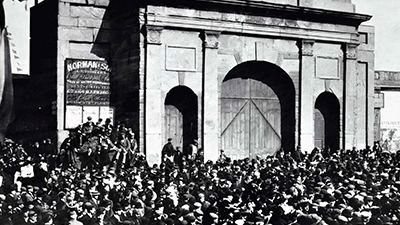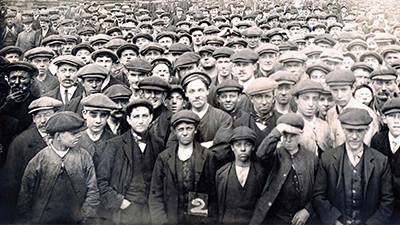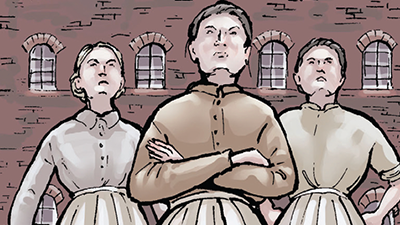The Working Class
Teacher Resources
Driving Question: How did workers respond to the conditions of industrial life?
In this lesson, you’ll explore what life was like for the growing working class, how people responded to harsh conditions, and how new ideas like socialism emerged to challenge industrial capitalism.
Learning Objectives:
- Use evidence to understand the impact of new economic theories and the modern system of social classes.
- Use a graphic biography to support, extend, or challenge the overarching narratives from this period.
Vocab Terms:
- capitalism
- communism
- proletariat
- salvation
- socialism
- tenement
- union
Opener: The Working Class
To teach this lesson step, refer to page 2 of the Lesson 7.7 Teaching Guide.
The Comparison One-Pager is a great reminder of why this skill is so important to understanding the past.
Start by examining how social and economic hierarchies shifted over time. These images will help you think about how industrialization changed who held power, and how workers responded to their place in society.
Pyramids of Capitalism
The Working Class
To teach this lesson step, refer to page 3 of the Lesson 7.7 Teaching Guide.
The Assembly Line Simulation is a great hands-on activity. Read about how other teachers have approached this activity in the Community Forum.
These materials show how industrialization changed both factory work and social class structure, helping us understand the growing divide between groups.
-
Guiding Questions
-
Before you read
Preview the questions below, and then skim the article. Be sure to look at the section headings and any images.
While you read
Look for answers to these questions:
- What inspired many reformers in the United States and Britain during the long nineteenth century?
- How did Lucretia Mott and Elizabeth Cady Stanton’s work in abolition lead to their fight for women’s rights?
- What reforms followed the Triangle Shirtwaist Factory fire?
- What did Upton Sinclair reveal in The Jungle, and what impact did that revelation have?
- What kinds of reforms were made to improve children’s lives during this period?
After you read
Respond to this question: What do you think was the most important factor in improving conditions for the working class in the nineteenth century?
Challenging Industrial Capitalism
To teach this lesson step, refer to page 6 of the Lesson 7.7 Teaching Guide.
Looking for supports to scaffold articles for your students? Pages 3-5 of the OER Project Reading Guide provides a wealth of ideas.
These materials show how the working class rose up to challenge the problems created by capitalism, and how thinkers like Marx imagined a different future.
-
Guiding Questions
-
Before you watch
Preview the questions below, and then review the transcript.
While you watch
Look for answers to these questions:
- How did industrial capitalism change how goods were made?
- What cultural values supported the rise of capitalism?
- What problems did industrial capitalism cause in the 1800s?
- Where did socialism first develop?
- What was socialism a reaction to?
After you watch
Respond to these questions: Do you think capitalism is good for people? What kinds of evidence would you need to help answer that question?
Key Ideas
-
Guiding Questions
-
Before you read
Preview the questions below, and then skim the article. Be sure to look at the section headings and any images.
While you read
Look for answers to these questions:
- What are the means of production?
- How did controlling the means of production give industrialists power?
- What was life like for industrial workers?
- What is the proletariat?
- How did workers organize to fight for better conditions?
After you read
Respond to this question: If you lived during the rise of the proletariat, would you have supported capitalism, socialism, or something else? Explain your choice.
Closer: The Working Class
To teach this lesson step, refer to page 8 of the Lesson 7.7 Teaching Guide.
Wanting to include more women in history class? QOTW // How do you include women in the story? // 2024 is full of ideas!
To wrap up this lesson, you'll take a closer look at one worker’s experience during industrialization. Ottilie Baader’s story gives a personal view of how factory life inspired new demands for rights, dignity, and reform.
Playing the Systems
To teach this lesson step, refer to page 9 of the Lesson 7.7 Teaching Guide.
Explore capitalism and socialism through a fast-paced classroom game. As you play through different rounds, you’ll see how resources get distributed and reflect on how those systems connect to the social and political movements of the industrial era.
The Human Side of Industry
To teach this lesson step, refer to page 12 of the Lesson 7.7 Teaching Guide.
These materials bring you face-to-face with the lived experiences of working-class people during industrialization. Through firsthand stories, you'll explore how class and gender shaped daily life—and why these realities led many to demand reform.
-
Guiding Questions
-
Before you watch
Preview the questions below, and then review the transcript.
While you watch
Look for answers to these questions:
- Why did children work as nailers at such a young age?
- How many nails did a child make per hour?
- How long did child nailers work each day?
- How did nail masters cheat their workers?
- Why is Mary-Ann Bird’s story important?
After you watch
Respond to this question: What does this video teach you about child labor and the power bosses had over working-class families?
Key Ideas
-
Guiding Questions
-
Before you watch
Preview the questions below, and then review the transcript.
While you watch
Look for answers to these questions:
- Why did people need to soak and beat clothes for at least 30 minutes?
- Why were chores like washing usually done by women and girls?
After you watch
Respond to this question: How does learning about Victorian washing help you understand gender roles and class during this time?











